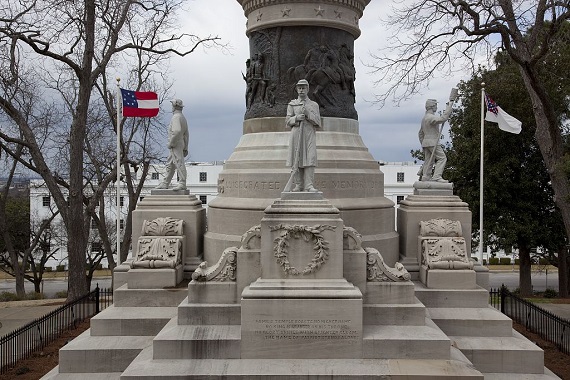This piece was originally printed at AntoniusAquinas.com.
On May 19, the House of Reprehensibles passed a proposal that would essentially ban the display of Confederate flags from national cemeteries. The amendment was added to a Veteran Affairs spending bill.
Not surprisingly, House Speaker Paul Ryan allowed the measure to be voted upon in hopes of not disrupting the appropriations process. Yes, by all means Paul, the redistribution of taxpayers’ confiscated wealth should take precedent over a draconian attempt to eradicate a heroic symbol of the country’s past. Hopefully, Ryan will be ousted this November as both Speaker and Congressman for not only his consistent sell out to Obummer and the Democrats on the budget, but his lack of understanding and appreciation of what is arguably the most important period of American history.
In a certain sense, the Confederate flag should not be displayed in national cemeteries or for that matter flown alongside those of the Union. The two are representations of dramatically opposed political ideologies. Liberals and political opportunists of all sorts have deliberately smeared the South’s attempt at secession as being entirely over the issue of slavery. The “Civil War” (which that struggle has become known by) is now seen through Politically Correct hindsight.
A civil war, in the truest sense, is a conflict between factions attempting to gain control of a government typically for their own aggrandizement. The bloody conflict between the North and South was not that, nor was it solely over slavery although the institution played a role in it.
The Confederacy wanted no part of the Washington establishment at the time, which it believed had become too tyrannical, and attempted to secede from it. The remaining states of the North, under the “leadership” of Abraham Lincoln, prevented this at the cost of more than 600,000 lives, the vast destruction of property, and the impoverishment of a people who simply sought to rule themselves.
The South’s action was nearly identical to what the colonies, North and South, did some 80 years previously in breaking away from the British Empire and becoming free and independent states under the benign rule of the Articles of Confederation.
As America’s Founding Fathers saw their liberties violated by King and Parliament, Southerners witnessed similar tyrannies and wisely anticipated more federal oppression with the election of Lincoln.
This interpretation has been ably supported by scholarship, though the view is rarely acknowledged in academia or in the mainstream media. In an essay from an insightful collection titled Secession, State and Liberty, Donald Livingston persuasively describes the ideological content of the Declaration of Independence, the revolution it inspired, and its influence on the South’s leadership.
He writes: “Overall, the Declaration is an argument designed to justify the secession of the new self-proclaimed American states from the British state. . . [It] is a document justifying the territorial dismemberment of a modern state in the name of the moral right of a people to self-government.”*
The South, imbued with such logic and the example of the Revolutionary generation’s break with Great Britain, attempted to separate from the Union on similar grounds and, in Livingston’s view, had a much stronger claim than the Founding Fathers had for independence:
[T]he colonies were not and never had been recognized as sovereign states, either by others or even by themselves. At the time of the Civil War, however, the southern states had been and still were sovereign states, and so they could mount not only a moral argument but a legal one as well. And it was the legal argument they primarily insisted upon. Each state used the same legal form to secede from the Union that it has used to enter, namely, ratification in a convention of people.**
Although slavery was a part of the South’s final break with the North, the Confederacy could never have been built on such a narrow foundation. Those who seek to paint Southern secession as a movement solely designed to protect their “peculiar institution” have either misunderstood the genesis of that struggle or do so for political gain.
While Southern secession is mercilessly condemned by the Establishment, scholars like Professor Livingston see it and the War for Southern Independence in a much different and far nobler light: “With the orderly, legal secession of the southern states, the American genius for self-government reached its highest moral expression.”***
The Northern and Southern flags which fly in national cemeteries across the land are indeed representative of different traditions, but not what the Politically Correct crowd would have everyone to believe.
The defenders of Dixie and the flags that commemorate their courageous actions have long since been morally justified. The Union flag, on the other hand, has been one of aggression and domination, at first, brutally directed at its fellow countrymen who simply sought self-determination, and afterwards against millions of peoples from Vietnam to Iraq.
Hopefully, in the not too distant future as economic conditions worsen and American hegemony can no longer be maintained, the Union flag and the empire in which it represents will receive greater vitriol than the Confederate flag has gotten for its innumerable mass murders, destruction, crimes, and chaos which it has wantonly brought to every corner of the planet.
*David Gordon, ed., Secession, State & Liberty. Donald W. Livingston, “The Secession Tradition in America.” New Brunswick (U.S.A.), Transaction Publishers, 1997, p. 7
** Ibid., 18.
*** Ibid., 19.







